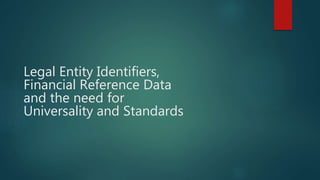LEI ON FIRE - April 2016
- 1. Legal Entity Identifiers, Financial Reference Data and the need for Universality and Standards
- 2. The need for Quality Hierarchal LEI data, DTI?? and other emerging Universal Financial data standards (UTI, UPI, et al) are enabled thru advanced contextual graph models plus exploitation of Blockchain technological disruptive capability Ontology2 4/7/2016 Bill Freeman, Paul Houle , Allan Grody, patent pending
- 3. Daily, GlEIF concatenates and archives the data Financial Stability Board, CFTC,OFR, Treasury Reg Oversight Committee, Basil, EC, Global regulators Global Legal Entity Identifier Foundation Local Operating Units LOUs register entities and supply data files to GLEIF established oversees Global LEI System(GLEIS): A Work in ProcessCurrent State Under Stress âĒ Individual Records are supposed to be updated at least yearly, but lapse rates for such updating is 25% âĒ (although they should LEI records must be updated sooner for corporate actions to make the GLEIS relevant for use as golden copy for internal use by financial institutions âĒ Ultimately Needed : Real-time , streaming data analytics to monitor SIFI, trading , and the buildup of systemic risk capital adequecy âĒ LOUs publish daily updates, which are consolidated daily by the GLEIF. Process and data variables at LOUâs problematic (i.e. ___________, ____________, __________) Note;add examples please âĒ A complete snapshot of the data is kept every day, giving a valuable record of system history Ontology2 4/7/2016
- 4. Current Challenges ïĩ Uncertain use and value of LEIs in recording transactions in Trade Repositories (TRs)â tens of billions of transactions have been sent to TRs with no way of validating LEIâs usefulness and quality ïĩ Different Internal Data and Communication Models at LOUâs will prohibit advanced technology deployment if not standardized ïĩ LEIs as mechanism to aggregate data on a hierarchical relationship basis is being put off to an uncertain outcome ïĩ The use of the GLEIS for aggregating financial transaction data for systemic risk analysis, the key objective for regulators, is not yet accommodated in either the rule making or the design of the GLEIS ïĩ The promise to financial industry members of straight-through-processing, significant infrastructure cost reduction and risk mitigation is not being realized, nor is it being identified in industry plans â near term or in the future ïĩ Little standard operating Procedure ïĩ Manual ïĩ Mutual Funds Ignored ( oretty much ) if not ïĩ Challenging to understand the quality of information, sources and audit
- 5. Reference Data As Seen By Financial IT Trading software Entity data Product data Trade data Analytics Reporting Risk management Straight-through processing (risk elimination) âĒ Needs immediate reaction to changes affecting entities Analytics, Reporting (Risk management) âĒ Need to understand current state AND also what reference data was relevant to the trade at the time Ontology2 4/7/2016
- 6. Current LEI System is Not Fast,Scalable or Secure Update Rates Suffer 5 days of daily updates requires 5 copies of the data 5 days of hourly updates requires 120 copies of the data (Note: assume you are showing a single LOU example â how many hours of operation to get to the calculations shown? Needs better example âĶ and hourly might not be fast enough to keep up with real-time trading and changing conditions under stress situations Ontology2 4/7/2016
- 7. Next-Generation LEI System Global Legal Entity Identifier Foundation manages Blockchain run collectively by Local Operating Units Blocks in chain represent changes to reference data published by Local Operating Units in conjunction with their registrants and their customers We get best of both worlds: Global update of reference data updated on a few second timescale AND Complete historical record at time of trade (keep block id for exact reference!) Ontology2 4/7/2016
- 8. Ontology2 Technology Enhances Blockchain ïĩ âLambda Architectureâ operation (âSuperbatchâ ) to process updates in either a large batch (whole database) or in small batches (one block) ïĩ Perfect for Blockchain! ïĩ Ablility to accept or reject changes from blockchain to minimize the effect that incorrect or malicious data from blockchain impacts operations, reporting or analysis ïĩ Semantic capability to represent, reason, and work with multiple representations of a situation (integrate blockchain-sourced reference data with legacy and future systems) Ontology2 4/7/2016
- 9. Index Cloud New Index Construction Never Conflicts With Production time Old index (multiple copies for throughput & availability) Source data Test Clone New Index Manage and recover resources Ontology2 4/7/2016
- 10. Intelligent Index ( ML ) plus Real-Time Index Build can be self correcting Effortless and efficient scalability Message Queue Bulk Data time stamped master data small real-time index large bulk index merger RESULTS Ontology2 4/7/2016
- 11. New approach to data management A FRAMEWORK FOR DATA QUALITY Multiple sources of instance data Facts classifications Reference dataâĶ Examples Test Data Training Data Requirements Quality metrics Ontology2 4/7/2016










